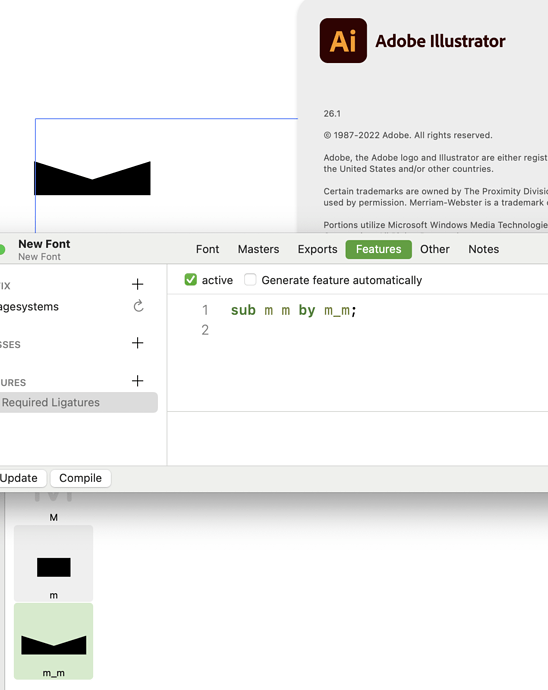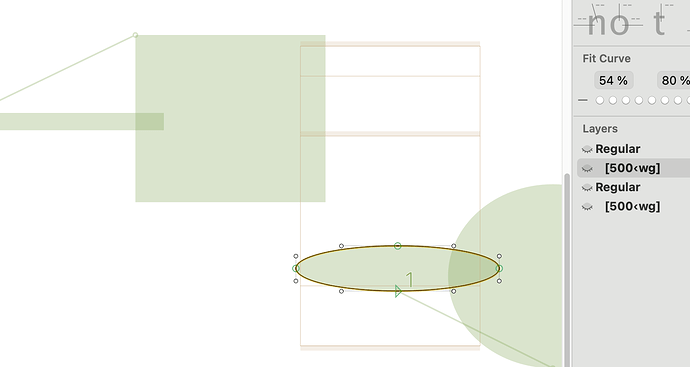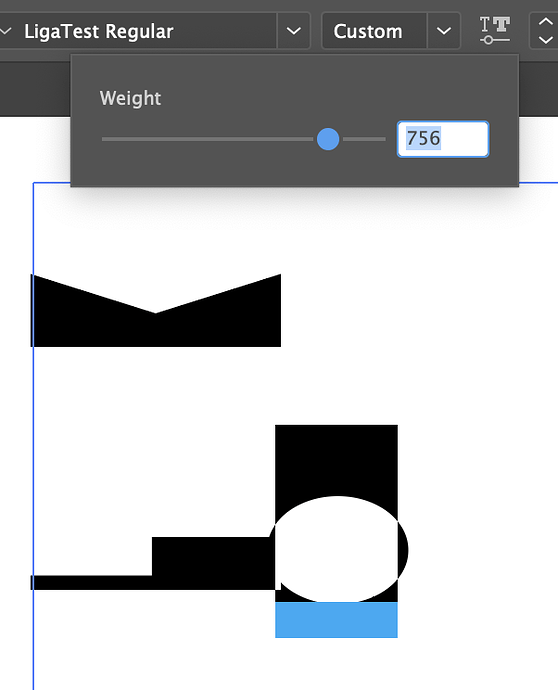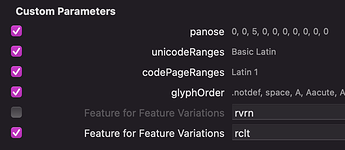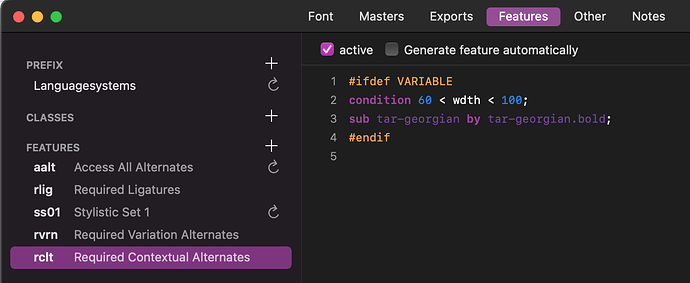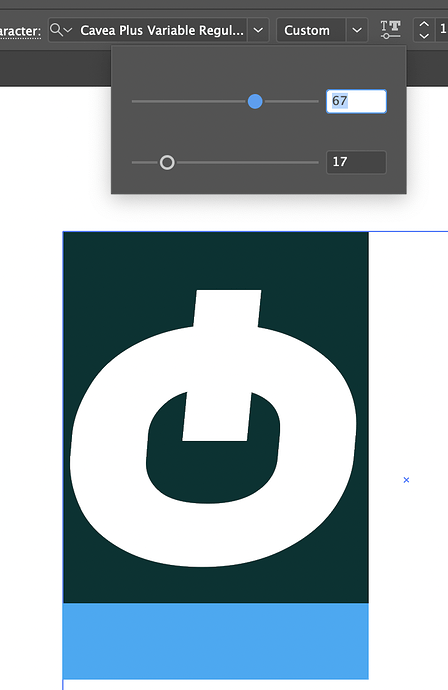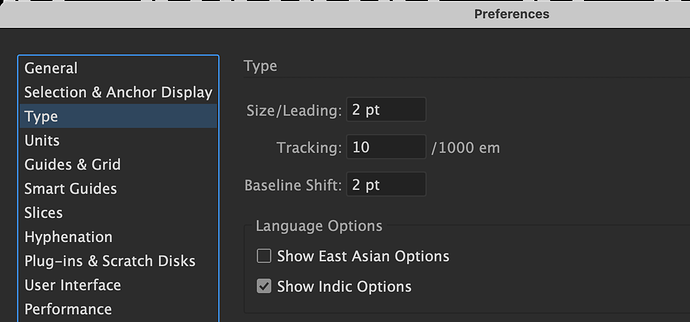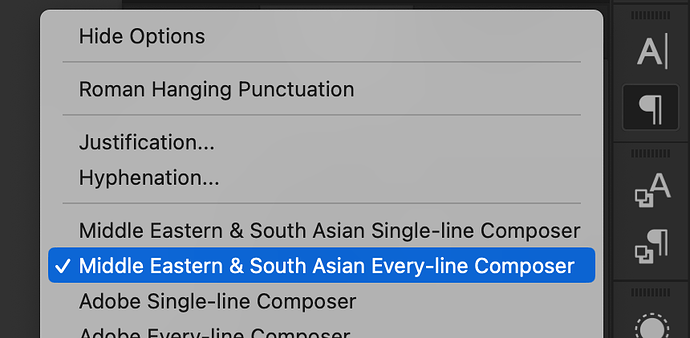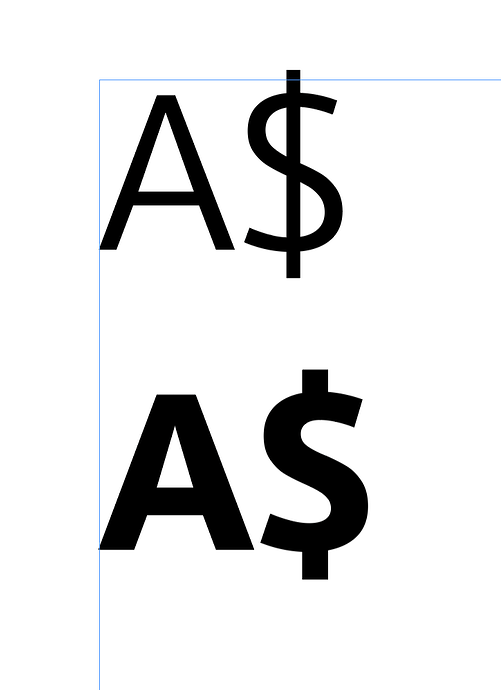Hi, I am working on a variable font with two axes (width and slant). I made alternative shape for particular glyph, it is working on a glyphs variable font preview, also I tested it on a website and it works fine, but it is not working on Adobe Illustrator, can anyone help?
Thanks
Glyphs uses the rlig feature tag for this by default, which is wrong because it’s meant to be used for ligatures, not variation alternates. Maybe they chose it for better compatibility, but Illustrator doesn’t support it.
Luckily you can change it with these instructions from the Switching Shapes tutorial:
You just need to set it to rvrn which is the correct feature tag for required variation alternates. This is supported in browsers and Adobe apps.
However there still are some potential problems with using rvrn as noted in the tutorial, but to solve that you would need to create your alternate glyphs separately and write your own feature code, which would look something like this:
#ifdef VARIABLE
condition slnt < -4.731;
sub a by a.italic;
sub aacute by aacute.italic;
sub acircumflex by acircumflex.italic;
sub adieresis by adieresis.italic;
sub agrave by agrave.italic;
sub aring by aring.italic;
sub atilde by atilde.italic;
sub ae by ae.italic;
sub b by b.italic;
sub d by d.italic;
sub e by e.italic;
sub eacute by eacute.italic;
sub ecircumflex by ecircumflex.italic;
sub edieresis by edieresis.italic;
sub egrave by egrave.italic;
sub f by f.italic;
sub g by g.italic;
sub k by k.italic;
sub l by l.italic;
sub m by m.italic;
sub n by n.italic;
sub ntilde by ntilde.italic;
sub p by p.italic;
sub q by q.italic;
sub r by r.italic;
sub u by u.italic;
sub uacute by uacute.italic;
sub ucircumflex by ucircumflex.italic;
sub udieresis by udieresis.italic;
sub ugrave by ugrave.italic;
sub y by y.italic;
sub yacute by yacute.italic;
sub ycircumflex by ycircumflex.italic;
sub ydieresis by ydieresis.italic;
sub ygrave by ygrave.italic;
sub ampersand by ampersand.italic;
#endif
And then what you can do is copy that code into multiple tags like rvrn and rlig so that it applies across any apps that support either tag.
You can put feature variations in any feature. The reason why we do not recommend rvrn is that it is only for default glyphs:
Typically, a Feature table referenced in a FeatureRecord with the ‘rvrn’ tag will have LookupCount set to 0; in this way, the default variation instance does not have any glyph substitution applied but, rather, uses default glyphs.
It will not work for substituted glyphs like small caps or stylistic sets. In that case, you will have to put it in those features, not rvrn. rlig is more broadly supported, but it seems like AI’s implementation is incomplete.
That is not correct. The rvrn feature is meant for some special purpose that nobody actually could explain to me. It does apply the feature variation as does every other feature. Yes, you can add feature variation to all features. Even stylistic sets. The rvrn feature has one big problem. As defined in the spec, it is applied before all other features. So it is only possible to have variations for encoded glyphs. But not for small caps, stylistic sets …
As I said before, any feature can hold feature variation. So we need to find a feature that is active by default and that allows us to control the time when it is applied. That leaves rlig and rclt. Both do work in Adobe apps — but they sometimes decide to forget that.
I’m not very good with feature code, but a glyph can be substituted multiple times, right? I don’t understand why rvrn can’t be used with non-encoded glyphs. Could you not simply write rvrn: sub a by a.italic and then ss01: sub a.italic by a.italic.ss01?
rlig and rclt are not always supported in Adobe apps. Only rvrn has universal support in my tests:
Illustrator 26
rclt ![]()
rlig ![]()
rvrn ![]()
InDesign 17
rclt ![]()
rlig ![]()
rvrn ![]()
Photoshop 23
rclt ![]()
rlig ![]()
rvrn ![]()
Chrome 100
rclt ![]()
rlig ![]()
rvrn ![]()
Safari 15.3
rclt ![]()
rlig ![]()
rvrn ![]()
Firefox 99
rclt ![]()
rlig ![]()
rvrn ![]()
rlig works as such as a normal ligature feature:
And a variable font with feature variations:
The setup in glyphs:
And a few instances in Illustrator:
So it works perfectly for me. As I said, it forgets that it can do this sometimes. There seems to be something in the font that Illustrator doesn’t like and it stops to apply the feature variations.
I did the same test with Feature for Feature Variations = rclt and it still works.
Indesign doesn’t seem to support rclt.
HI, thank you all for your help. I tried both versions, Alternate layers (‘bracket layers’) and Alternate glyphs. I also tried rclt rlig rvrn, nothing seems to work. I will try to explain it with screens so it is more clear what I mean, because at this point I don’t know what I have to do.
this are the glyphs I want to switch “tar-georgian” to “tar-georgian-bold”
Maybe I am doing something wrong, or missing some step
Why have an a.italic at all then, and not make it the default? Because it would always trigger in rvrn.
No, the solution is to add the condition to ss01. There is no point in forcing it into rvrn.
How do you know it doesn’t work? How do you test? If in Illustrator: can you try in FontGoggles or a web browser first? Just to exclude bad implementations in AI.
Thats the problem, it works everywhere except Adobe illustrator, and unfortunately Illustrator is the program that I need it for.
The condition would be in rvrn in my example – I should have mentioned it, but I thought it was implied by the italic scenario. This makes more sense to me than having multiple conditions in different tags:
[rvrn]
#ifdef VARIABLE
condition slnt < -4.731;
sub a by a.italic;
#endif
[ss01] #automatically generated by Glyphs
sub a.italic by a.italic.ss01;
However, now that I’ve tested this, it works in FontGoggles and on the web, but the ss01 substitution does not trigger in Illustrator.
Can you send me the file? I’ll have a look why it doesn’t work in Illustrator.
When I export the font from the latest glyphs it works fine for me in Illustrator. I disabled all the “rvrn” and “rclt” feature. I installed the font in “/Library/Application Support/Adobe/Fonts/Tests/CaveaPlusVariableVF.ttf”. My Illustrator version is 26.1
What is the actual version number?
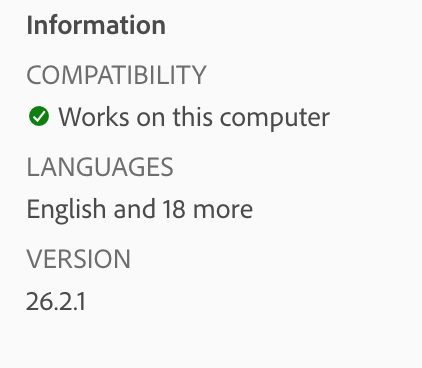
I will set up the new glyphs file and test it, thank you so much for your help
By the way, I was running into frustrations with rlig in Illustrator, and found that it only works for me when I am using the “Middle Eastern” line composer (in Version 26.1 and Version 27). To activate that, I had to go to Illustrator Preferences, then Type, then go into the Paragraph panel and its flyout options.
It seems wild that it’s this difficult to activate such a seemingly basic feature…
Just to let you know that on Illustrator 27.6 and the latest glyphs build (3.241) the RLIG implementation is not working, but RVRN does work
RLIG works fine in all browsers and font goggles though so it’s definitely an Adobe issue

